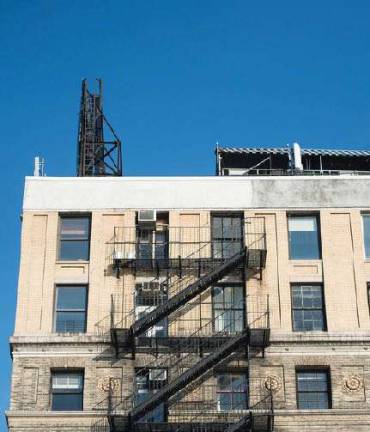Fighting for historic Tribeca

Residents scramble to landmark a 120-year-old building slated for demolition
TRIBECA The noble fortress on the edge of Tribeca is not going to surrender quietly.
The building located at 67 Vestry Street was once home to a number of prolific New York artists but now the warehouse-turned-creative space is at risk of being torn down. That's unless the current residents, with help from a local preservation society, can convince city officials that the nearly 120-year old structure is worth restoring.
Developer Aby Rosen purchased the nine-story building overlooking the Hudson River in 2005 and, in February, announced his intention to demolish it to construct a 11-story, 42-unit monolith in its place.
However the residents who live there now warn that Rosen's approach would take away one of the few artifacts still surviving from early New York. They're campaigning to have the building included in the Tribeca landmark district, a process that can take years but could be 67 Vestry's only hope to stay standing.
Originally designed by Frederick Dinkelberg ? who, along with Daniel Burnham, also designed the Flatiron Building ? 67 Vestry was constructed in 1897. The Great Atlantic and Pacific Tea Company (now known as A&P) used it as a warehouse for the Washington Market. It was here where hundreds of regional farmers would congregate daily, shouting over each other for the attention of shoppers hoping to buy vegetables from New Jersey or a basket of strawberries from as far south as the Carolinas.
This rich history should not only be preserved but celebrated, says Lynn Ellsworth, the chair of Tribeca Trust, a small organization working to ensure that modern skyscrapers will coexist alongside historical landmarks. She said 67 Vestry's inclusion on the landmark directory is vital if the community wants to remember a bygone era.
"The owner may not be interested in being in the historic district but it's not just his judgment call on this," Ellsworth said. "Historic districts create a large public good that endures through time and its there for the benefit of many generations."
The now nearly forgotten market was closed in the mid-20th Century. What was once a crucial link between New York and the surrounding area, though, was transformed into a bohemian's dream.
By the 1970s and '80s a thriving art community had taken root inside 67 Vestry, with Andy Warhol, sculptor John Chamberlain, playwright Robert Wilson, and others taking up some of the residential space. The German auteur Wim Wenders even displayed the building prominently in the 1977 film, "An American Friend," starring Dennis Hopper.
Decades later the building has become a neighborhood touchstone, with artists, architects and others proud to take up 15 of the 24 rent-stabilized units. Members of We Are 67 Vestry Street, a group of residents dedicated to raising awareness about the building's history and its current difficulty, said that nine former tenants have been evicted since Rosen's purchase and the vacant space will likely remain that way at least until the landmark battle is resolved.
This building is one of only four remaining waterfront buildings from the Tribeca of a century ago. None of the them have been granted landmark status, and two of the four could be demolished in the near future.
Ms. Ellsworth, who compared the building's facade to that of a fortress, said developing the area through preservation and re-adaptive use would be the smart public decision. Groups like hers are not opposed development, only change that refuses to recognize New York's distinct history.
"I think there's another notion to modernity, where you have a connection to the past instead of alienation and divorce from it," she said. "I want to feel like part of the stream of it. I think a lot of people do, and I do not feel alone in this."